Announcing: Catalog #318 (for May, 2022) – Rare & Early Newspapers (for purchase)
April 30, 2022 by GuyHeilenman · Leave a Comment
|
|
The links above will redirect to the latest catalog in approx. 30 days,
upon which time it will update to the most recent catalog.
Edward Gallaway – bibliophile, publisher, circus performer, cardshark – help needed…
April 25, 2022 by GuyHeilenman · Leave a Comment
A collecting friend is doing research on Edward Gallaway (1868-1930). Perhaps the collecting community can help. He sent the following note:
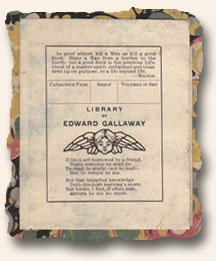
You can help a research project into a largely unknown bibliophile from Chicago, Edward Gallaway, by checking if you have any of the following in your collection:
1) Anything with the bookplate shown in the image.
2) Any issue or clipping from the Payne Weekly People, published in Fort Payne Alabama in October of 1889. This weekly newspaper, published by Edward Gallaway, discontinued roughly a year later end of 1890. This town experienced a boom during those years and many investors hailed from Massachusetts. Thus issues may have been transported back to the New England region.
3) Any issue from the Fort Payne Journal before 1891.
4) Any issue from the Fort Payne Herald.
5) Any issue from the Delphos Kleeblatt before 9th May 1891. The Delphos Kleeblatt was a German newspaper out of Delphos, Ohio, published by Carl A. Jettinger, who was a friend of Edward Gallaway.
Edward Gallaway had a fascinating life. He was born in Delphos, Ohio, in 1868. Already with 14 he became a printer’s devil at the local Delphos Weekly Herald newspaper, where he learned the printer’s art. From 18 years old to 21 he worked as a traveling typesetter. Eventually, he followed his older brother Alexander August Gallaway to Fort Payne, Alabama, where he established the short lived Payne Weekly Newspaper during the coal and iron boom years there. After the boom collapsed, Edward completely changed course and he became a circus performer working from 1892 until about 1895 at small traveling circuses such as the W.D. Ament sideshow. He performed mostly under the stage name Prof. Charles P. Wilson. His act consisted of Punch and Judy as well as magic. He would also work as barker, canvass boss man, as well as sideshow manager.
Edward Gallaway had a secret life as a cardshark. Later in 1902 he would write a manual of sleight-of-hand with cards educating readers on cheating at the card table as well as how to perform magic card tricks. This book, The Expert at the Card Table, was published under the pseudonym S.W. Erdnase, and it is to this day the most important book on sleight-of-hand with cards. It was decades ahead of its time.
Eventually, he found back to his printing profession and he started either alone or with others various job printing business, all of which were short lived. Around 1900 he is employed by the Bentley Murray printing company where he honed his skill on the Monotype typesetting machine which lead him to write the Monotype System books and other educational matter for Lanston Monotype. He started to teach estimating at the United Typothetae which brought him to the attention of Donnelley where he was later employed as estimator. There he rose up through the ranks to reach the position of director of estimating. In other words, he was the chief estimator at the largest privately owned printing company in the US. In 1925 he left and established his own School for Estimating in Chicago, the only school focusing on that particular aspect of printing. He died 1930 in Chicago.
During his life Edward Gallaway accumulated a large library with many precious books which his wife after his death sold through Chicago second-hand book dealers. This was the ‘pension’ she lived on until her death in 1943.
If anyone can be helpful in regards to this research project, please contact me (Guy) at guy@rarenewspapers.com. Thanks.
Exploring “This Day in History” through Rare & Early Newspapers…
April 22, 2022 by GuyHeilenman · Leave a Comment
Who among us isn’t a bit curious as to what occurred on our birthday (or today’s date) through time? The concept of exploring a specific day (month/day) through history has always been intriguing, but before the internet, such knowledge was not easy to obtain. However, in the present world of data explosion, websites which explore “This Day in History” do the job quite nicely and have become very popular. One of my favorites is HISTORY.COM maintained by The History Channel.
Of course, as a collector and reseller of old newspapers, this trek is amplified by the capability of holding authentic newspapers containing contemporary reporting of these events – to not only read the articles themselves, but to explore the context of what else was going on as the events unfolded.
Thanks to ongoing requests from collectors, we’ve created an interface on our website which enables the seeker to explore what is available at any given moment for any month/day. Even if you are not looking to add to your collection, perusing through the issues can be fascinating. If you have interest in giving this a try, the steps below are provided to help you get started.
This feature is available at: Explore: “THIS DAY IN HISTORY”
– – –
I tried own birthday and came up with the following: January 2nd Through Time
Don’t forget the “Sort” feature which will give you multiple ways to arrange your search results. Have Fun!

A Fly on the Wall at the Lincoln-Douglas Debates…
April 18, 2022 by GuyHeilenman · Leave a Comment
 As I sat down to write this post, I was reminded that a year ago I wrote another post titled “A Fly of the Wall …” which ironically, was also about Lincoln. This time Lincoln had an adversary who also drew me in – who made me, once again, desire to be a fly on the wall.
As I sat down to write this post, I was reminded that a year ago I wrote another post titled “A Fly of the Wall …” which ironically, was also about Lincoln. This time Lincoln had an adversary who also drew me in – who made me, once again, desire to be a fly on the wall.
On August 26, 1858, THE NEW YORK TIMES reported on the now-famous Lincoln-Douglas debates. While coverage of the debates is difficult to find in newspapers because it was a senate race and Lincoln was, at this time, still a relatively unknown figure in American politics, sometimes you find a gem. Page 5 contains a report headed: “Douglas and Lincoln at Ottawa–Personal Reminiscences” which begins: “Messrs. Douglas and Lincoln had a grand tilt at Ottawa, Ill., last week. Mr. Douglas’ speech contained this amusing passage:…”, and what follows is an excerpt of a Douglas’ speech. There is something particularly engaging about two great thinkers, with many polar-opposite views, battling it out with their most useful weapons: words. Go ahead and admit it, you wish you could have been a fly right there with me.
Take a Closer Look … The Delicate Details of Woodcut Prints…
April 14, 2022 by Laura Heilenman · 1 Comment
I have had some fascinating conversations this past year with one of our collecting friends who is an expert in woodcut prints. I won’t be a name dropper, however, if he is reading this, he will have no doubt as to who I am referencing. I greatly appreciate the time he took to share his knowledge which has motivated me to pause and look more carefully at every print I encounter in the RareNewspapers archives. My proficiency in this area is sparse and not terribly reliable but I did want to share a few takeaways.
Some artists of woodcut prints would draw on paper and send the illustration to a publisher who would cut the paper into tiny square blocks and have each one sketched onto a square block of wood. These wooden squares would be handed out to different craftsmen who would carve their block and then the blocks would be rejoined for printing. Sometimes, when time was of the essence, each craftsman would use carving tools which could create many tiny lines at once. If you look closely at many such illustrations, you can tell these prints have hundreds of parallel lines – indicating the use of these tools. Occasionally, when more time was available, each line was formed individually – a painstaking process, but one which produced an almost unimaginable degree of detail!
Some artists preferred to draw their own prints directly onto the wood and so they were sent a group of one-inch square pieces bound together with twine. When the artist had finished their drawing, the publisher would untie the pieces and distribute the blocks to the woodcarvers.
Regardless of how each print was created, the detail, craftsmanship and artistic skill needed to produce one illustration is mind blowing. So, the next time you glance through a Harper’s Weekly, Leslie’s Illustrated , Illustrated London News, or handful of other illustrated titles of the “woodcut era”, perhaps you will join me in pausing and giving a bit of deference to these creators of beauty. Thanks Bill for sharing this delightful insight with me.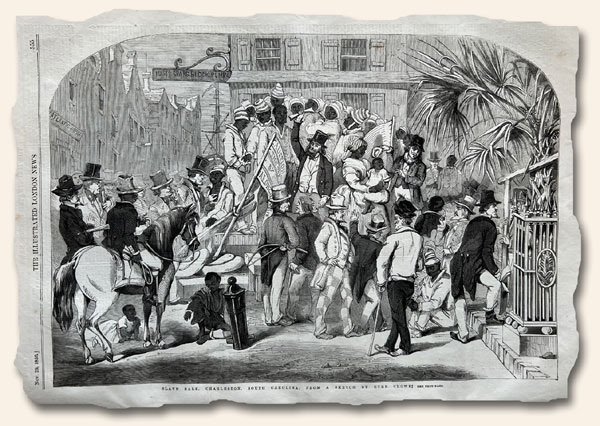
Great Headlines Speak for Themselves… The Sinking of the Titanic!
April 11, 2022 by GuyHeilenman · Leave a Comment
The best headlines need no commentary. While there are many dramatic headlines regarding the Sinking of the Titanic, the April 16, 1912, New York American is considered one of the very best: “J. J. ASTOR LOST ON TITANIC” “1500 TO 1,800 DEAD” (see below). Of course, the striking illustration certainly helps. We also have a nice Pinterest board with Titanic headlines: Titanic
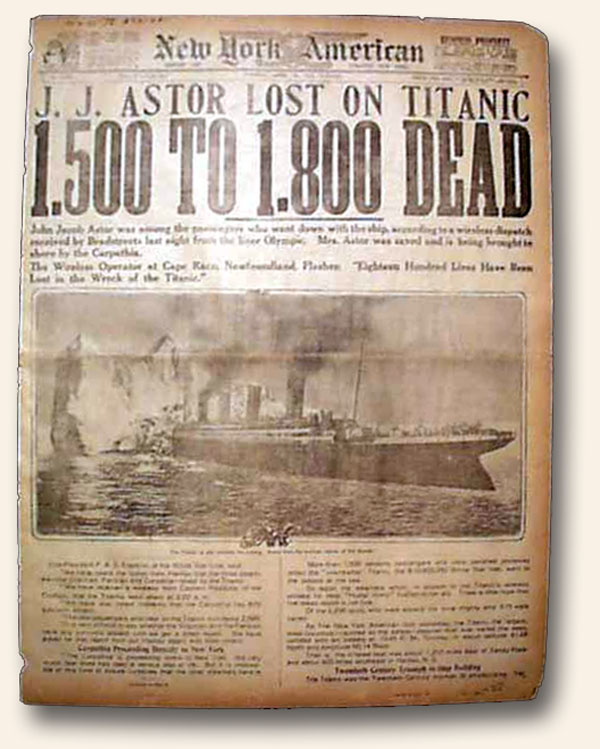
Snapshot 1844 – Voter Fraud… “death by a thousand cuts…”
April 8, 2022 by GuyHeilenman · Leave a Comment
Political scientist Robert Dahl defines a free and fair election as one in which “coercion” is comparatively uncommon.
Did voter fraud occur in the 2020 U.S. Presidential election? Of course. To think otherwise would be naive. Some degree of fraud has likely occurred in most, if not all elections which involve an imperfect people. This may seem a bit jaded, but I’m actually encouraged by the degree to which most elections in America have been “free and fair”. Still, complaints regarding election fraud have been documented throughout our history. True? In some cases, yes. Enough to impact the final outcome? It’s hard to know.
One such cry came from Louisiana in 1844, and was recorded in the National Intelligencer dated Nov. 30, 1844 (originally printed in the New Orleans Bee). Truth be told, fraud cannot be stopped. However, for the sake of the confidence of the electorate (i.e., to preserve a free and fair election), every intention must be made to keep it to a minimum – while not inhibiting citizens from voting. Balancing both is no small task – but is worth our ongoing effort.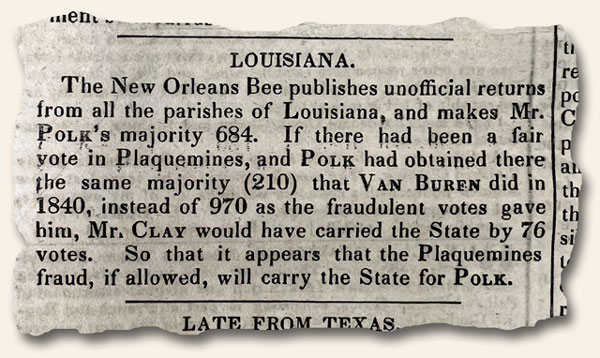
Insight into the mind of Tesla…
April 4, 2022 by Laura Heilenman · Leave a Comment
I am always dumfounded by the breadth of brilliance some well-known inventors of the past possessed. Leonardo da Vinci, who is credited with the invention of the parachute, the barreled cannon, the Helical aerial screw, the winged flying machine, diving equipment & the self-propelled cart, also painted the Mona Lisa. How can one not stand in awe? Let’s face it, inventors are often trend setters who give the world around them inspiration as well as practical solutions for common problems.
 On Oct. 14, 1893, SCIENTIFIC AMERICAN featured an article by Nikola Tesla which caught my attention. We think of Tesla as one of the 2-3 most famous “explorers” who contributed to our current-day electrically powered world. However, in this article, he is using his study of the eye to further his insight into electrical currents. Below is a fitting quote from the article by this genius from the late 19th and early 20th centuries:
On Oct. 14, 1893, SCIENTIFIC AMERICAN featured an article by Nikola Tesla which caught my attention. We think of Tesla as one of the 2-3 most famous “explorers” who contributed to our current-day electrically powered world. However, in this article, he is using his study of the eye to further his insight into electrical currents. Below is a fitting quote from the article by this genius from the late 19th and early 20th centuries:
“The day when we shall know what ‘electricity’ is, will chronicle an event probably greater and more important than any other in the history of the human race.” Much ground has been covered in this regard since he made this statement, but most would agree we have yet to arrive.



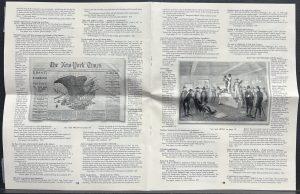 May’s catalog (#318) is now available. Also shown below are links to a video featuring highlights from the catalog, our currently discounted newspapers, and recent posts to the History’s Newsstand Blog. Please enjoy.
May’s catalog (#318) is now available. Also shown below are links to a video featuring highlights from the catalog, our currently discounted newspapers, and recent posts to the History’s Newsstand Blog. Please enjoy.